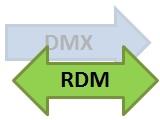The first versions (up to version from 22.01.2013) of DMXSerial2 was not stable during several tests I did and often a response package did not reach the controller as expected.
After some testing with inserted delayMicroseconds() functions and time probes in several places I found that the implementation with the Arduino processor and the DMX Shield was sometimes too fast for the used controllers and the DMX line.
In several publications for example in http://www.soundlight.de/techtips/dmx512/dmx_rdm.htm you can find the timing requirements defined by the RDM standard and it seems that it is very important to follow them strictly.
The one timing condition that is indeed implemented by the RDM client is the time between the end of a RDM command that is sent by the controller and the start of the RDM response that is sent by the client.
Because the answer to a command is created asynchronously in the tick() function this time was varying and was often shorter than the expected minimal 176 µsec .
The version from 01.03.2013 and later now saves the time when the last byte of a command was sent into a global variable and delays the start of the answer when appropriate. After implementing this delay mechanism the RDM communication was much more stable then before.
And there is the RDM-BREAK that is longer than the DMX-BREAK: min. 176 µsec instead of 88 µsec.
I published the updated Arduino project today. It’s still work in progress and a library format will be available soon.
See http://www.mathertel.de/Arduino/DMXSerial2.aspx
 I just published the version 1.0 of the DMX RDM library as an Arduino library with sample code.
I just published the version 1.0 of the DMX RDM library as an Arduino library with sample code.